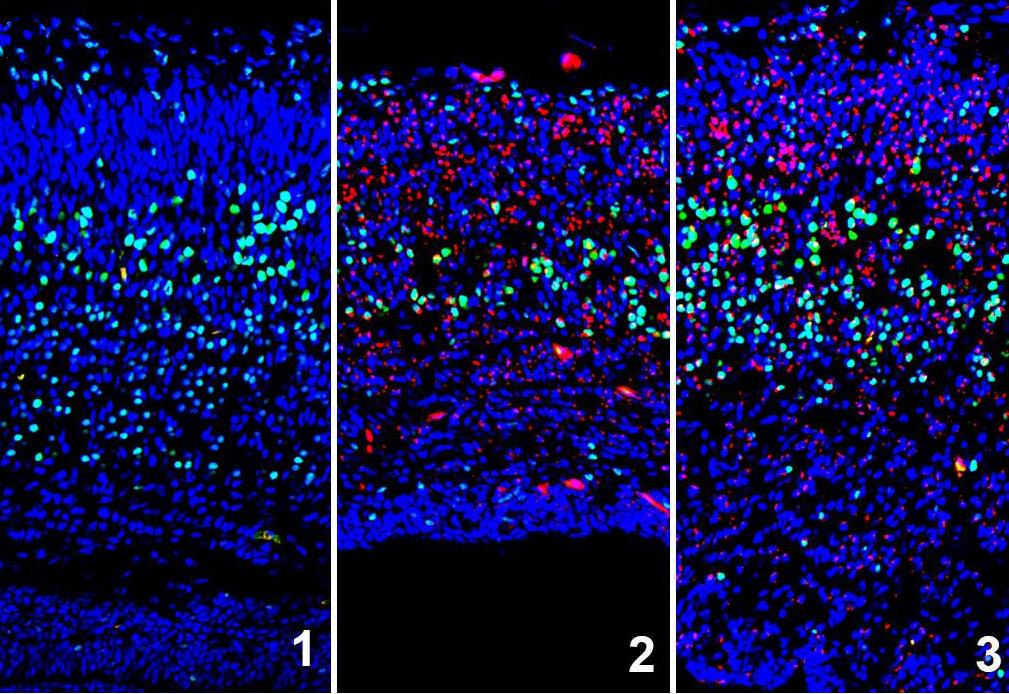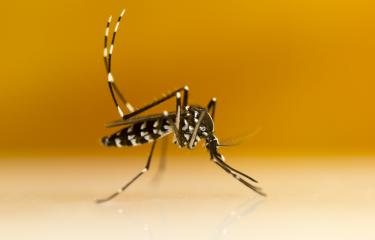A team of researchers from ZIKAlliance discovers a specific mechanism of the infection
Epidemiological studies show that in utero fetal infection with the Zika virus (ZIKV) may lead to microcephaly, an irreversible congenital malformation of the brain characterized by an incomplete development of the cerebral cortex. However, the mechanism of Zika virus-associated microcephaly remains unclear. An international team of researchers within the European consortium ZIKAlliance (coordinated by Inserm in France) has identified a specific mechanism leading to this microcephaly. Their findings are published this week in Nature Neuroscience.
To understand this mechanism, the scientific team led by Dr. Laurent Nguyen (frs-F.N.R.S., GIGA Neuroscience, University of Liège) and Prof. Marc Lecuit (Institut Pasteur, Inserm, University Paris Descartes, Necker Children's Hospital, AP-HP) combined analysis of human fetuses infected with Zika virus, cultures of human neuronal stem cells and mice embryos. They showed that ZIKV infection of cortical progenitors (stem cells for cortical neurons) controlling neurogenesis triggers a stress in the endoplasmic reticulum (where some of the cellular proteins and lipids are synthetized) in the embryonic brain, inducing signals in response to incorrect protein conformation (referred to as “unfolded protein response”).
When it reaches the brain, Zika virus infects neuronal stem cells, which will generate fewer neurons, and by inducing chronic stress in the endoplasmic reticulum, it promotes apoptosis, i.e. the early death of these neuronal cells. These two combined mechanisms explain why the cerebral cortex of infected fetuses becomes deficient in neurons and is therefore smaller in size.
"These discoveries demonstrate a hypothesis that we had made following a basic research study we had just carried out in our laboratory, and thus confirm the physiological importance of the unfolded protein response in the control of neurogenesis," says Laurent Nguyen.
Researchers continued their studies on mice by administering inhibitors of protein-folding response in cortical progenitors and found that this inhibited the development of microcephaly in mice embryos infected with Zika virus.
Furthermore, the defects observed are specific to an infection by ZIKV, as other neurotropical viruses of the flavivirus family (West Nile virus, yellow fever,...) did not cause microcephaly, in contrast to Zika virus.
According to Prof. Marc Lecuit, "these results illustrate how studying fundamental biological processes is an essential step in understanding the mechanisms of infections, and lead to novel therapeutic strategies."

Zika virus infection leads to microcephaly in mice by inducing ER stress. Mouse Zika-induced microcephaly is prevented by injecting a drug that selectively reduces the transduction of the “unfolded protein response” (UPR) triggered by the ER stress.
Brains of embryonic (E) day 18.5 mice infected (2, 3) or not (1) with Zika viruses and treated with vector (2) or a blocker of ER stress (3) at E12.5. Coronal sections through corresponding mouse brains showing the immunolabeling of Zika virus (NS1, red), deep layer neurons (CTIP2, green), and nuclei (DAPI, blue).
About Zika virus
The infection by the Zika virus is a mosquito-transmitted disease similar to dengue, yellow fever or West Nile disease. Although the infection often causes mild symptoms in adults, including fever and rash, it has been shown in recent months that Zika virus can be transmitted from the mother to her foetus, and cause microcephaly. It can also be the case of severe paralysis that can reach respiratory muscles and lead to death in adults (Guillain-Barré syndrome).
EU: €45 million funding for research and prevention of the Zika virus
The EU supports research to develop treatments, diagnostics, vaccines and better risk assessment for Zika virus. The majority of the funding (€30 million) is allocated to three research consortia: ZIKAPLAN (€11 million), coordinated by the University of Umeå in Sweden, ZIKAction (€7 million), coordinated by the PENTA Foundation in Italy, and ZIKAlliance (€12 million), coordinated by Inserm in France. Researchers from Europe, Brazil and other Latin American and Caribbean countries are collaborating in these consortia to learn more about Zika virus infection and its consequences for pregnant women, newborns and adults, as well as to develop improved diagnostic tests and identify the best treatment and prevention options.
More info: www.zikalliance.tghn.org @ZIKAlliance
Source
Stress-induced unfolded protein response contributes to Zika virus-associated microcephaly, Nature Neuroscience, December 11, 2017, doi 10.1038/s41593-017-0038-4
Ivan Gladwyn-Ng (1), Lluis Cordon Barris (1), Christian Alfano (1), Catherine Creppe (1), Thérèse Couderc (2,3), Giovanni Morelli (1,4), Nicolas Thelen (1), Michelle America (1), Bettina Bessières (5,6), Férechté Encha-Razavi (5),Maryse Bonnière (5), Ikuo K. Suzuki (7), Marie Flamand (8), Pierre Vanderhaeghen (7,9), Marc Thiry (1), Marc Lecuit (2,3,10*) and Laurent Nguyen (1*)
(1) GIGA-Neurosciences, Interdisciplinary Cluster for Applied Genoproteomics (GIGA-R), University of Liège, C.H.U. Sart Tilman, Liège, Belgium.
(2) Institut Pasteur, Biology of Infection Unit, Paris, France.
(3) Inserm U1117, Paris, France.
(4) BIOMED - Hasselt University, Hasselt, Belgium.
(5) Département d’Histologie-Embryologie-Cytogénétique, Hôpital Necker-Enfant Malades, Paris, France.
(6) Inserm U 1163 Institut Imagine, Paris, France.
(7) Université Libre de Bruxelles (ULB), Institute for Interdisciplinary Research, (IRIBHM), and ULB Institute of Neuroscience (UNI), Brussels, Belgium.
(8) Institut Pasteur, Structural Virology Unit, Paris, France.
(9) WELBIO, Université Libre de Bruxelles, Brussels, Belgium.
(10) Paris Descartes University, Sorbonne Paris Cité, Division of Infectious Diseases and Tropical Medicine, Necker-Enfants Malades University Hospital, Institut Imagine, Paris, France.
Ivan Gladwyn-Ng, Lluis Cordon Barris, Christian Alfano, Catherine Creppe and Thérèse Couderc contributed equally to this work.
* Corresponding author





